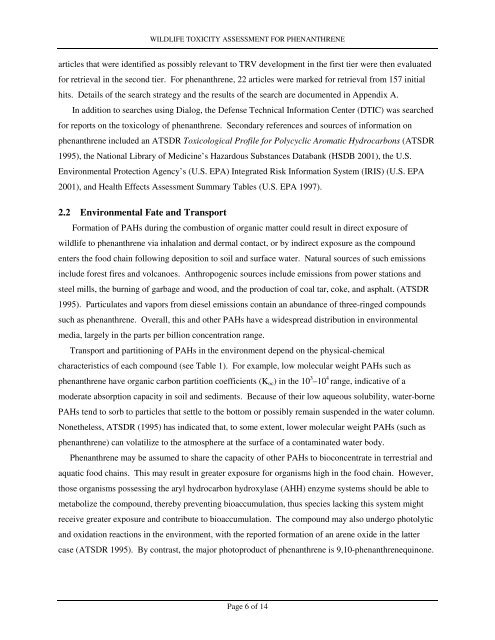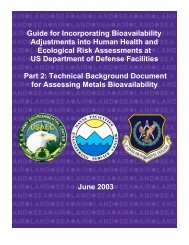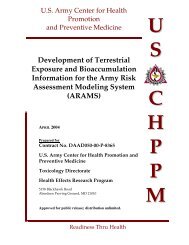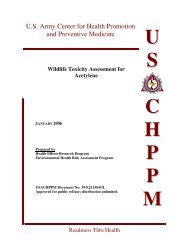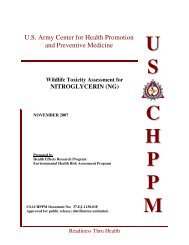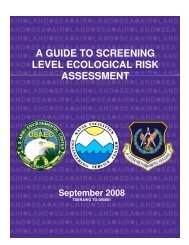Phenanthrene - U.S. Army Public Health Command
Phenanthrene - U.S. Army Public Health Command
Phenanthrene - U.S. Army Public Health Command
Create successful ePaper yourself
Turn your PDF publications into a flip-book with our unique Google optimized e-Paper software.
WILDLIFE TOXICITY ASSESSMENT FOR PHENANTHRENEarticles that were identified as possibly relevant to TRV development in the first tier were then evaluatedfor retrieval in the second tier. For phenanthrene, 22 articles were marked for retrieval from 157 initialhits. Details of the search strategy and the results of the search are documented in Appendix A.In addition to searches using Dialog, the Defense Technical Information Center (DTIC) was searchedfor reports on the toxicology of phenanthrene. Secondary references and sources of information onphenanthrene included an ATSDR Toxicological Profile for Polycyclic Aromatic Hydrocarbons (ATSDR1995), the National Library of Medicine’s Hazardous Substances Databank (HSDB 2001), the U.S.Environmental Protection Agency’s (U.S. EPA) Integrated Risk Information System (IRIS) (U.S. EPA2001), and <strong>Health</strong> Effects Assessment Summary Tables (U.S. EPA 1997).2.2 Environmental Fate and TransportFormation of PAHs during the combustion of organic matter could result in direct exposure ofwildlife to phenanthrene via inhalation and dermal contact, or by indirect exposure as the compoundenters the food chain following deposition to soil and surface water. Natural sources of such emissionsinclude forest fires and volcanoes. Anthropogenic sources include emissions from power stations andsteel mills, the burning of garbage and wood, and the production of coal tar, coke, and asphalt. (ATSDR1995). Particulates and vapors from diesel emissions contain an abundance of three-ringed compoundssuch as phenanthrene. Overall, this and other PAHs have a widespread distribution in environmentalmedia, largely in the parts per billion concentration range.Transport and partitioning of PAHs in the environment depend on the physical-chemicalcharacteristics of each compound (see Table 1). For example, low molecular weight PAHs such asphenanthrene have organic carbon partition coefficients (K oc ) in the 10 3 –10 4 range, indicative of amoderate absorption capacity in soil and sediments. Because of their low aqueous solubility, water-bornePAHs tend to sorb to particles that settle to the bottom or possibly remain suspended in the water column.Nonetheless, ATSDR (1995) has indicated that, to some extent, lower molecular weight PAHs (such asphenanthrene) can volatilize to the atmosphere at the surface of a contaminated water body.<strong>Phenanthrene</strong> may be assumed to share the capacity of other PAHs to bioconcentrate in terrestrial andaquatic food chains. This may result in greater exposure for organisms high in the food chain. However,those organisms possessing the aryl hydrocarbon hydroxylase (AHH) enzyme systems should be able tometabolize the compound, thereby preventing bioaccumulation, thus species lacking this system mightreceive greater exposure and contribute to bioaccumulation. The compound may also undergo photolyticand oxidation reactions in the environment, with the reported formation of an arene oxide in the lattercase (ATSDR 1995). By contrast, the major photoproduct of phenanthrene is 9,10-phenanthrenequinone.Page 6 of 14


